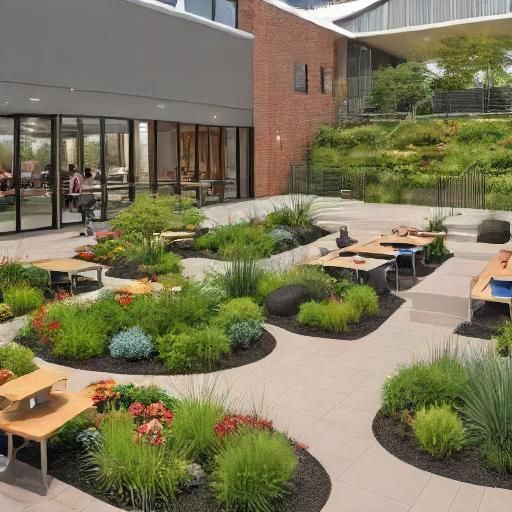The Impact of School Beautification on Student Learning or School beautification refers to efforts to improve the physical appearance and environment of educational institutions. These efforts can range from simple acts like planting flowers to more comprehensive projects such as renovating buildings or creating outdoor learning spaces. The impact of school beautification on student learning is profound and multifaceted, affecting not only academic performance but also students’ emotional well-being, social skills, and overall attitude towards school.
Academic Performance
Several studies have demonstrated a direct correlation between a school’s physical environment and student academic performance. A well-maintained and aesthetically pleasing school environment can lead to improved concentration, higher motivation, and better attendance rates. For instance, a study by the American Society of Interior Designers found that students in well-designed classrooms scored 25% higher on tests than those in poorly designed classrooms. The improved environment helps reduce distractions, enabling students to focus better on their studies.
Furthermore, school beautification projects often involve the creation of outdoor learning spaces. These areas provide students with a dynamic and engaging learning environment that can enhance their understanding of various subjects, particularly science and environmental studies. Outdoor classrooms and gardens offer hands-on learning experiences that can make abstract concepts more concrete and easier to grasp.

Emotional Well-being
The emotional impact of a beautified school environment on students is significant. A pleasant and inviting school atmosphere can reduce stress and anxiety, leading to a more positive school experience. When students feel comfortable and happy in their surroundings, they are more likely to engage in learning and participate actively in school activities.
Incorporating natural elements such as plants, trees, and flowers into the school environment has been shown to have therapeutic effects. Nature has a calming influence and can help reduce feelings of stress and aggression. Schools that integrate green spaces and nature-inspired designs create a serene environment that promotes mental well-being. This, in turn, supports better learning outcomes, as students are more likely to thrive in a positive emotional state.
Social Skills and Community Engagement
School beautification projects often require collaboration and teamwork, providing students with opportunities to develop their social skills. Working together on a common goal fosters a sense of community and belonging among students. These projects can also involve the wider community, including parents, teachers, and local organizations, creating a shared sense of pride and ownership in the school.
Engaging in beautification efforts can also instill a sense of responsibility and civic duty in students. When they see the tangible results of their work, they gain a sense of accomplishment and learn the value of contributing to their community. This can lead to increased respect for their school and a desire to maintain its appearance, promoting long-term positive behaviors.
Attitude Towards School
The overall attitude of students towards their school can be greatly influenced by the environment in which they learn. A clean, well-maintained, and aesthetically pleasing school can foster a sense of pride and respect among students. When students are proud of their school, they are more likely to take their education seriously and develop a positive attitude towards learning.
On the other hand, a neglected and unattractive school environment can have the opposite effect. Students in such environments may feel undervalued and unmotivated, leading to disengagement and lower academic performance. Therefore, investing in school beautification is an investment in students’ attitudes and their overall educational experience.
Case Studies and Real-World Examples
Several schools around the world have successfully implemented beautification projects with notable positive outcomes. One such example is the Edible Schoolyard Project at Martin Luther King Jr. Middle School in Berkeley, California. This project transformed a vacant lot into a thriving garden where students learn about gardening, nutrition, and sustainability. The hands-on experience has not only improved students’ knowledge in these areas but also fostered a greater appreciation for their environment and healthier eating habits.
Another example is the Green School in Bali, Indonesia, which integrates sustainability into its curriculum and school design. The school’s bamboo structures and lush green surroundings create a unique learning environment that emphasizes the importance of environmental stewardship. Students at Green School benefit from an immersive educational experience that combines academic learning with practical skills and a deep connection to nature.
Challenges and Considerations
While the benefits of school beautification are clear, there are challenges to consider. Funding is a significant hurdle, as beautification projects can be costly. Schools must often rely on fundraising, grants, and community donations to support these efforts. Additionally, maintaining the beautified environment requires ongoing effort and resources, which can be a challenge for schools with limited budgets.
Another consideration is the need for community involvement and buy-in. Successful beautification projects often require the support and participation of students, parents, teachers, and community members. Ensuring that all stakeholders are committed to the project and understand its value is crucial for its long-term success.
Conclusion
School beautification has a profound impact on student learning, encompassing academic performance, emotional well-being, social skills, and attitudes towards school. By creating a pleasant and engaging learning environment, schools can foster a positive educational experience that supports student success. Despite the challenges, the benefits of beautification projects make them a worthwhile investment for any educational institution. Through collaboration and community support, schools can create environments that not only enhance learning but also inspire pride and a sense of belonging among students.

k4r40r
Excellent read, I just passed this onto a friend who was doing a little research on that. And he just bought me lunch as I found it for him smile Therefore let me rephrase that: Thanks for lunch!
Nikmati Permainan Slot Gacor di sigmaslot dengan RTP Tinggi dan Jackpot Menggoda
28vzcq
I¦ve recently started a site, the information you offer on this website has helped me greatly. Thank you for all of your time & work.
There are some attention-grabbing time limits in this article but I don’t know if I see all of them center to heart. There’s some validity but I will take hold opinion until I look into it further. Good article , thanks and we want more! Added to FeedBurner as nicely
This really answered my problem, thank you!
Hello, you used to write magnificent, but the last several posts have been kinda boring… I miss your super writings. Past few posts are just a bit out of track! come on!
Amazing blog! Is your theme custom made or did you download it from somewhere? A theme like yours with a few simple adjustements would really make my blog stand out. Please let me know where you got your design. Appreciate it
Good write-up, I am regular visitor of one?¦s site, maintain up the excellent operate, and It’s going to be a regular visitor for a long time.
I’d have to examine with you here. Which is not one thing I usually do! I take pleasure in reading a post that may make folks think. Additionally, thanks for permitting me to comment!
My family alll the time say hat I am killing my time here at
web, but I know I am getting familiarity all the time bby readinng thes nice
articles or reviews.
Also visit mmy site; จัดไม้งานศพ
Undeniably believe that which you said. Your favorite justification seemed to be on the nnet the simplest thing to
be aware of. I say to you, I definitely gett irked while people think about worriees that they plainly don’t know about.
You managed to hit the nail upon the top and defined out the whole thing without having
side-effects , people could take a signal.
Will liksly be back to get more. Thanks
my web site: ออกแบบโลโก้ตามหลักฮวงจุ้ย
Glad to be one of several visitors on this amazing site : D.
What a material of un-ambiguity and preserveness of valuable knowledge about unexpected emotions.
my webpage; ฮวงจุ้ยโลโก้
I really enjoy good vintage wine. Whether it’s red or white, it’s the perfect way to relax.
Who else eenjoys wine tasting? #WineTasting
my page – Gregory
I was suggested this blog byy my cousin. I’m not sure whether this post is wwritten by him aas nobody else know such detailed about my
problem. You are wonderful! Thanks!
Feel free to visit my page ออกแบบโลโก้ตามหลักฮวงจุ้ย
I’m a huge fan off good vintage wine. From a local vineyard or
imported, it just elevates any occasion. Anyone else here love wine?
#WhiteWine
Also visit my homepage: ไวน์ ออนไลน์
ขอบคุณสำหรับบทความดี ๆ ครับ ถ้าใครกำลังมองหาผู้ให้บริการตกแต่งงานศพ ผมแนะนำลองดูร้านที่มีผลงานจริงและรีวิวดี ๆ ครับ
my website: https://Exagame.ru/index.php?subaction=userinfo&user=FredStreet
บทความนี้ให้ข้อมูลมีประโยชน์มากครับ
ถ้าใครกำลังมองหาบริการจัดดอกไม้งานศพ ผมแนะนำลองดูร้านที่มีผลงานจริงและรีวิวดี ๆ ครับ
Stoop by my website – Blog.wswl.org
ขอบคุณสำหรับบทความดี ๆ ครับ ถ้าใครกำลังมองหาร้านจัดดอกไม้งานศพ ผมแนะนำลองดูร้านที่มีผลงานจริงและรีวิวดี
ๆ ครับ
My blog post Aorest
I’m a huge fan of good wine. Doesn’t matter if it’s dry or sweet,
iit just elevates any occasion. Anyone else here love wine?
#WineTasting
Here is my site ขายไวน์
อ่านแล้วเข้าใจง่ายดี ที่พูดถึง IQOS Thailand เห็นภาพรวมทั้งหมดเลย
เคยลองใช้แล้วประทับใจ
มีรีวิวเปรียบเทียบรุ่นไหมคะ
ขอบคุณสำหรับบทความดี ๆ
ครับ ถ้าใครกำลังมองหาร้านจัดดอกไม้งานศพ ผมแนะนำลองดูร้านที่มีผลงานจริงและรีวิวดี ๆ ครับ
Feel free to surf tto my web blog … Maria
ขอบคุณสำหรับบทความดี ๆ ครับ ถ้าใครกำลังมองหาร้านจัดดอกไม้งานศพ ผมแนะนำลองดูร้านที่มีผลงานจริงและรีวิวดี ๆ ครับ
Also visit my web site: http://Misojin.co
Can’t get enough of goood glass of wine. Doesn’t matter if it’s dry
or sweet, it just elevates any occasion. Are there any wine lovers around?
#RedWine
My web blog – ขายไวน์ยกลัง
Can’t get enough of good vintage wine.
Doesn’t matter if it’s dry or sweet,
it’s the perfect way to relax.Anyone else here love wine?
#WineTasting
ขอบคุณสำหรับข้อมูลเกี่ยวกับพวงหรีดที่ชัดเจน
โดยส่วนตัวเพิ่งเจอเหตุการณ์สูญเสีย การเลือกดอกไม้งานศพเลยเป็นเรื่องที่ต้องใส่ใจ
จะบอกต่อให้เพื่อนๆ ที่ต้องการเลือกดอกไม้ไปงานศพอ่านด้วย
Look into my web blog … จัดดอกไม้งานศพ
This is a very good tips especially to those new to blogosphere, brief and accurate information… Thanks for sharing this one. A must read article.
I loved as much as you will receive carried out right here. The sketch is attractive, your authored subject matter stylish. nonetheless, you command get got an edginess over that you wish be delivering the following. unwell unquestionably come further formerly again as exactly the same nearly very often inside case you shield this increase.
บทความนี้ให้ข้อมูลมีประโยชน์มากครับ ถ้าใครกำลังมองหาผู้ให้บริการตกแต่งงานศพ ผมแนะนำลองดูร้านที่มีผลงานจริงและรีวิวดี ๆ ครับ
Check out my blog; ดอกไม้หน้าโรง
I’m really loving the theme/design of your web site. Do you ever run into any internet browser compatibility problems? A handful of my blog readers have complained about my blog not working correctly in Explorer but looks great in Safari. Do you have any solutions to help fix this issue?